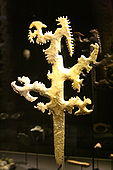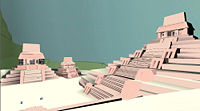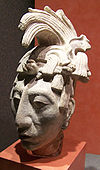
Maya art
Encyclopedia


Maya civilization
The Maya is a Mesoamerican civilization, noted for the only known fully developed written language of the pre-Columbian Americas, as well as for its art, architecture, and mathematical and astronomical systems. Initially established during the Pre-Classic period The Maya is a Mesoamerican...
, that took shape in the course the Preclassic period (1500 BC to 250 AD), and grew greater during the Classic period (c. 200 to 900 AD), and went through a Postclassic phase until the upheavals of the sixteenth century destroyed courtly culture and put an end to their artistic tradition. The Olmec
Olmec
The Olmec were the first major Pre-Columbian civilization in Mexico. They lived in the tropical lowlands of south-central Mexico, in the modern-day states of Veracruz and Tabasco....
s, Teotihuacan
Teotihuacan
Teotihuacan – also written Teotihuacán, with a Spanish orthographic accent on the last syllable – is an enormous archaeological site in the Basin of Mexico, just 30 miles northeast of Mexico City, containing some of the largest pyramidal structures built in the pre-Columbian Americas...
and the Toltec
Toltec
The Toltec culture is an archaeological Mesoamerican culture that dominated a state centered in Tula, Hidalgo in the early post-classic period of Mesoamerican chronology...
s have all influenced Maya art. Traditional art forms have mainly survived in weaving and the design of peasant houses.
Architecture

A unique and spectacular style, Maya architecture spans several thousands of years. Yet, often the most dramatic and easily recognizable as Maya are the stepped pyramids from the Terminal Pre-classic period and beyond. Being based on the general Mesoamerican architectural traditions these pyramids relied on intricate carved stone in order to create a stair-step design. Each pyramid was dedicated to a deity whose shrine sat at its peak. During this "height" of Maya culture, the centers of their religious, commercial and bureaucratic power grew into large cities, including Chichen Itza, Tikal, and Uxmal. Through observation of the numerous consistent elements and stylistic distinctions, remnants of Maya architecture have become an important key to understanding the evolution of their ancient civilization.
At the heart of the Maya city existed the large plazas surrounded by their most valued governmental and religious buildings such as the royal acropolis, great pyramid temples and occasionally ballcourts. Though city layouts evolved as nature dictated, careful attention was placed on the directional orientation of temples and observatories so that they were constructed in accordance with Maya interpretation of the orbits of the stars. Immediately outside of this ritual center were the structures of lesser nobles, smaller temples, and individual shrines: the less sacred and less important structures had a greater degree of privacy. Outside of the constantly evolving urban core were the less permanent and more modest homes of the common people.
All evidence seems to suggest that most stone buildings existed on top of a platform sub-structure that varied in height from less than a meter, in the case of terraces and smaller structures, to 45 meters in the case of great temples and pyramids. A flight of often steep stone steps split the large stepped platforms on at least one side, contributing to the common bi-symmetrical appearance of Maya architecture. Depending on the prevalent stylistic tendencies of an area, these platforms most often were built of a cut and stucco stone exterior filled with densely packed gravel. As is the case with many other Maya relief, those on the platforms often were related to the intended purpose of the residing structure. Thus, as the sub-structural platforms were completed, the grand residences and temples of the Maya were constructed on the solid foundations of the platforms. As all structures were built, little attention seems to have been given to their utilitarian functionality and much to their external aesthetics; however, a certain repeated aspect, the corbeled arch, was often utilized to mimic the appearance and feel of the simple Maya hut. Though not an effective tool to increase interior space, as it required thick stone walls to support the high ceiling, some temples utilized repeated arches, or a corbelled vault, to construct what the Maya referred to as pibnal, or sweatbath, such as those in the Temple of the Cross at Palenque. As structures were completed, typically extensive relief work was added, often to the covering of stucco used to smooth any imperfections; however, many lintel carvings have been discovered, as well as actual stone carvings used as a facade. Commonly, these would continue uninterrupted around an entire structure and contain a variety of artwork pertaining to the inhabitants or purpose of a building. Though not the case in all Maya locations, broad use of painted stucco has been
discovered as well.
Sculpture

Sculpture
Sculpture is three-dimensional artwork created by shaping or combining hard materials—typically stone such as marble—or metal, glass, or wood. Softer materials can also be used, such as clay, textiles, plastics, polymers and softer metals...
s out of different materials, mainly of stone, wood, stucco, and jade. A common form of Maya sculpture was the stela
Maya stelae
Maya stelae are monuments that were fashioned by the Maya civilization of ancient Mesoamerica. They consist of tall sculpted stone shafts and are often associated with low circular stones referred to as altars, although their actual function is uncertain. Many stelae were sculpted in low relief,...
. These were large stone slabs covered with carvings. Most of them depict the rulers of the cities they were located in, often disguised as gods. The stelae almost always contain hieroglyphic texts, which have been critical to determining the significance and history of Maya sites. The steles from Tonina
Tonina
Tonina is a pre-Columbian archaeological site and ruined city of the Maya civilization located in what is now the Mexican state of Chiapas, some 13 km east of the town of Ocosingo....
and Copan
Copán
Copán is an archaeological site of the Maya civilization located in the Copán Department of western Honduras, not far from the border with Guatemala. It was the capital city of a major Classic period kingdom from the 5th to 9th centuries AD...
approach sculptures in the round; those from Tikal have deep relief; from Palenque
Palenque
Palenque was a Maya city state in southern Mexico that flourished in the 7th century. The Palenque ruins date back to 100 BC to its fall around 800 AD...
, otherwise a true Maya capital of the arts, no significant stelae have been preserved.
Another major group of stone carvings consists of stone lintels
Lintel (architecture)
A lintel can be a load-bearing building component, a decorative architectural element, or a combined ornamented structural item. It is often found over portals, doors, and windows.-Structural uses:...
spanning doorways and relief panels set in the walls of buildings. A third group is constituted by altars, rounded or rectangular; those of the petty kingdom of Quirigua have an almost surrealist quality.
Sculptures in wood must once have been extremely common, but have rarely survived; the existent examples include, however, wooden lintels from some of the main Tikal temples, with their sharp detail.
Stucco sculpture adorned the facades of many buildings and was usually painted. Unique in Mesoamerica, it includes realistic portraiture of a quality equalling that of Roman ancestral portraits, with the lofty stucco heads of Palenque rulers and portraits of dignitaries from Tonina
Tonina
Tonina is a pre-Columbian archaeological site and ruined city of the Maya civilization located in what is now the Mexican state of Chiapas, some 13 km east of the town of Ocosingo....
as outstanding examples. The portrait modeling recalls that of certain Jaina ceramic statuettes.
The Mayans were fond of jade
Jade
Jade is an ornamental stone.The term jade is applied to two different metamorphic rocks that are made up of different silicate minerals:...
. Many stone carvings had jade inlays, and there were also ritual objects created from jade. It is remarkable that the Maya, who had no metal tools, created such objects from jade (jadeite
Jadeite
Jadeite is a pyroxene mineral with composition NaAlSi2O6. It is monoclinic. It has a Mohs hardness of about 6.5 to 7.0 depending on the composition. The mineral is dense, with a specific gravity of about 3.4. Jadeite forms solid solutions with other pyroxene endmembers such as augite and diopside ,...
), a very thick and dense material. An example is the death mask of K'inich Janaab' Pakal, ruler of Palenque
Palenque
Palenque was a Maya city state in southern Mexico that flourished in the 7th century. The Palenque ruins date back to 100 BC to its fall around 800 AD...
. A life-size mask created for his corpse had "skin" made from jade and "eyes" made from mother-of-pearl
Nacre
Nacre , also known as mother of pearl, is an organic-inorganic composite material produced by some mollusks as an inner shell layer; it is also what makes up pearls. It is very strong, resilient, and iridescent....
and obsidian.
Painting & Drawing

Central America
Central America is the central geographic region of the Americas. It is the southernmost, isthmian portion of the North American continent, which connects with South America on the southeast. When considered part of the unified continental model, it is considered a subcontinent...
, few Mayan paintings have survived to the present day. The colourful Bonampak murals, dating from 790 AD and decorating the interior of a temple, show scenes of nobility, battle, and sacrifice. At San Bartolo
San Bartolo (Maya site)
San Bartolo is a small pre-Columbian Maya archaeological site located in the Department of Petén in northern Guatemala, northeast of Tikal and roughly fifty miles from the nearest settlement...
, murals dating from 100 BC were recently discovered which relate to the myth of the Maya maize god
Maya maize god
Like other Mesoamerican peoples, the traditional Mayas recognize in their staple crop, the maize, a vital force with which they strongly identify. This is clearly shown by their mythological traditions. According to the 16th-century Popol Vuh, the Hero Twins have maize plants for alter egos and man...
; the colours are subtle and muted, the style, although very early, is already fully developed. Wall painting has also been found in caves such as Naj Tunich
Naj Tunich
Naj Tunich is a natural cave and an important archaeological site in Guatemala.The discovery of the Naj Tunich caves, in Poptún southern Peten, Guatemala, in 1979 initiated the interest for Cave Archeology among Mayanists...
.
A beautiful turquoise blue colour has survived through the centuries due to its unique chemical characteristics, this color is called Maya Blue
Maya Blue
Maya Blue is a unique bright azure blue pigment manufactured by cultures of pre-Columbian Mesoamerica, such as the Maya and Aztec.-Manufacture:...
(Azul Maya). It is present in Bonampak
Bonampak
Bonampak is an ancient Maya archaeological site in the Mexican state of Chiapas. The site is approximately south of the larger site of Yaxchilan, under which Bonampak was a dependency, and the border with Guatemala...
, El Tajín
El Tajín
El Tajín is a pre-Columbian archeological site and was the site of one of the largest and most important cities of the Classic era of Mesoamerica. The city flourished from 600 to 1200 C.E. and during this time numerous temples, palaces, Mesoamerican ballcourts and pyramids were built...
Cacaxtla
Cacaxtla
Cacaxtla is an archaeological site located near the southern border of the Mexican state of Tlaxcala. It was a sprawling palace containing vibrantly colored murals painted in unmistakable Maya style. The nearby site of Xochitecatl was a more public ceremonial complex associated with Cacaxtla...
, Jaina, and even in some Colonial Convents. The use of Maya Blue survived until the 16th century, when the technique was lost.
Writing
The Maya writing system consists of about 1000 distinctive characters or hieroglyphs ('glyphs'), and like many ancient writing systems is a mixture of syllabic signs and logogramLogogram
A logogram, or logograph, is a grapheme which represents a word or a morpheme . This stands in contrast to phonograms, which represent phonemes or combinations of phonemes, and determinatives, which mark semantic categories.Logograms are often commonly known also as "ideograms"...
s. This script was in use from the 3rd century BCE until shortly after the Spanish conquest in the 16th century. Today, most characters have a reading, which does not mean that their configuration as a text can always be understood. The glyphs themselves are highly detailed, and particularly the logograms are deceivingly realistic. Side by side with the monumental forms, there existed a cursive script of an often dynamic character, used in the folding-books, on walls, and on ceramics. Often, the captions are enclosed in square 'boxes' of various shapes within the representation. Since there were many Maya kingdoms, there existed as many regional styles.
The books were folded and consisted of paper or leather leafs with an adhesive stucco layer on which to write; they were protected by jaguar skin covers or, perhaps, wooden boards. Since every diviner probably needed a book, there must have existed large numbers of them. What still existed in the Yucatec kingdoms once the Spaniards moved in, was confiscated and destroyed. Bishop De Landa
Diego de Landa
Diego de Landa Calderón was a Spanish Bishop of the Roman Catholic Archdiocese of Yucatán. He left future generations with a mixed legacy in his writings, which contain much valuable information on pre-Columbian Maya civilization, and his actions which destroyed much of that civilization's...
writes: 'We found a large number of books in these characters and, as they contained nothing in which were not to be seen as superstition and lies of the devil, we burned them all, which they (the Maya) regretted to an amazing degree, and which caused them much affliction.' Three codices
Maya codices
Maya codices are folding books stemming from the pre-Columbian Maya civilization, written in Maya hieroglyphic script on Mesoamerican bark cloth, made from the inner bark of certain trees, the main being the wild fig tree or Amate . Paper, generally known by the Nahuatl word amatl, was named by...
(from Dresden, Paris, and Madrid) are still in existence; the authenticity of a fourth one (Grolier) is disputed. They are largely of a divinatory and priestly nature, containing horoscopes, almanacs, astrological tables, and ritual programs; only the Paris Codex also includes katun
Katun (Maya calendar)
A k'atun or k'atun-cycle is a unit of time in the Maya calendar equal to 20 tuns or 7,200 days, equivalent to 19.713 tropical years. It is the 2nd digit on the normal Maya long count date...
-prophecies. Texts and illustrations (partly coloured) hold the balance.
Ceramics
_01.jpg)
Fresco
Fresco is any of several related mural painting types, executed on plaster on walls or ceilings. The word fresco comes from the Greek word affresca which derives from the Latin word for "fresh". Frescoes first developed in the ancient world and continued to be popular through the Renaissance...
technique of applying paint to a wet clay surface. The decorative programs vary: palace scenes, courtly ritual, mythology, divinatory glyphs, or even dynastical texts taken from chronicles. Sculptural ceramic art includes incense burners, particularly from the kingdom of Palenque, and hand or mold-made figurines, sometimes used as ocarina's. The figurines are often of an amazing liveliness and realism. Apart from deities and rulers, they show many scenes and characters taken from daily life and sacrifice ritual. Some of these figurines may have been actually used in rituals, while others may have served more mundane purposes. The most impressive examples stem from Jaina Island.
See also
- Painting in the Americas before ColonizationPainting in the Americas before ColonizationPainting in the Americas before colonization is the Precolumbian painting traditions of the Americas. Painting was a relatively widespread, popular and diverse means of communication and expression for both religious and utilitarian purpose throughout the regions of the Western Hemisphere...
- Pre-Columbian artPre-Columbian artPre-Columbian art is the visual arts of indigenous peoples of the Caribbean, North, Central, and South Americas until the late 15th and early 16th centuries, and the time period marked by Christopher Columbus' arrival in the Americas....
- Visual arts by indigenous peoples of the Americas
- San Bartolo (Maya site)San Bartolo (Maya site)San Bartolo is a small pre-Columbian Maya archaeological site located in the Department of Petén in northern Guatemala, northeast of Tikal and roughly fifty miles from the nearest settlement...
Further study
- Works of George KublerGeorge KublerGeorge Alexander Kubler was an American art historian and among the foremost scholars on the art of Pre-Columbian America and Ibero-American Art....
- Works by Dorie Reents-Budet
- Works by Henri Stierlin
- Works of Alfred TozzerAlfred TozzerAlfred Marston Tozzer was an American anthropologist, archaeologist, linguist, and educator. His principal area of interest was Mesoamerican, especially Maya, studies. He was the father of figure skating champion Joan Tozzer....
- Works of Paul Westheim and Mariana Frenk-WestheimMariana Frenk-WestheimMariana Frenk-Westheim was a writer of Spanish-Mexican prose, hispanist, lecturer of literature, museum expert and one of the most important Mexican translators....
External links
- Web page of the Maya Blue Pigment
- Maya Art with Photos
- Journey through Art History: Maya Art
- Copan Sculpture Museum: Ancient Maya Artistry in Stucco and Stone. Barbara Fash. Published by the Peabody Museum Press. Paperback 2011.

